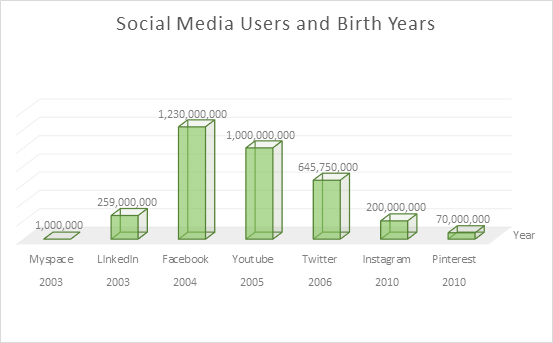If you have not seen some of these statistics you may be surprised to find out that:
- Twitter’s fastest growing demographic is 55-64 year olds.
- Facebook’s fastest growing demographic is 45-54.
- YouTube reaches more US adults aged 18-34 than any cable network.
- Every second two new members join LinkedIn.
- LinkedIn has a lower percentage of active users than Pinterest, Google+, Twitter and Facebook
- 189 million of Facebook users are ‘mobile only’
Why choose social media?
Due to the development of social media networks over the last 10 years and the increase in smart phone technology which has enabled frequent and easy access to these platforms, social media has never been more powerful. Social media has steadily integrated into our daily lives taking precedent over TV which has seen a downwards turn in viewership of almost 50% since 2002.

Social media marketing looks to take advantage of this by participating within the networks to increase not only brand awareness, traffic and sales, but also to participate and engage with this communities, ultimately protecting brands and raising awareness of them.
Social media really isn’t a one size fits all, nor are all channels as effective to all brands. The key is adapting to the audience. Therefore, you need to make everything you do in the channels highly relevant, transparent and measurable.
But where do you start?
When it comes to social media you always start by understanding your customer and defining your goals, then you look to find the most relevant social platform for your customers and the most relevant and beneficial KPI required to achieve your goals.
Tips for managing social media platforms
Facebook:
- Know your preferences and manage them within the admin panel.
- Make use of ‘Insights’ to see what actually drives engagement.
- Keep track of Facebook’s changing guidelines as they often alter their terms of service.
Twitter:
- Share valuable content in your own voice or the voice of the brand/company.
- Make a list of keywords relevant to your community, industry and brand. Remember to include them in your tweets.
- Cultivate relationships and organise your community. Add your tweeters and retweeters into a list and regularly review the content, share, participate and thank them to build relationships of value.
Youtube:
- Review YouTube insights to see what is popular and gaining attention.
- Adapt your content to user demographics and topics.
- Create content that addresses your audience’s needs. Be helpful, insightful and genuine.
LinkedIn:
- Complete your profile accurately to represent you and your brand.
- Use LinkedIn’s demographic segmentation features to develop content for the relevant audiences.
- Engage directly and with communication that is professional, encourages trust and builds you and your brand’s authority.
Pinterest:
- As with all channels, measure the success, refine, adapt and repeat.
- The power of the image. Use your images to attract and engage the audience. Every photo should be high quality, properly edited and easy to identify the topic.
- Remember to use search terms and keywords in your image names.





